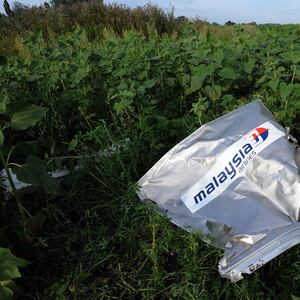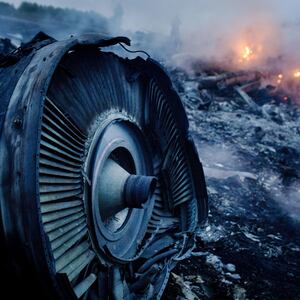It’s been nearly five years since the Malaysia Airlines Flight 17 passenger plane was shot down by a Russian missile over eastern Ukraine, killing 298 people. Finally, the victims’ families may see those responsible brought to justice.
Four suspects will face murder charges for the downing of MH17 in July 2014 and a trial is set to start next March in the Netherlands, investigators confirmed Wednesday. The Dutch-led investigation team revealed that three of the four have direct links to the Kremlin through previous work in the FSB and GRU intelligence services.
The four will be prosecuted for causing the crash, leading to the death of all the people on board, and separately for murdering all 298 passengers. International and national arrest warrants have been issued for the four, and the Netherlands will request that Russia questions the three Russian nationals who are still believed to be living in the country.
ADVERTISEMENT
The most senior suspect was named as Igor Girkin. Investigators described Girkin as a former FSB colonel who was appointed “minister of defense” in the so-called Donetsk People’s Republic—the region where MH17 was downed—making him the highest-ranking officer there at the time of the attack. He was in “direct contact” with Russia, investigators said.
The second suspect was named as Sergey Dubinskiy, who was previously employed by Russia’s GRU military intelligence service. Investigators described him as the deputy head of intelligence services in Donetsk, making him the second-highest-ranking suspect named publicly.
The third Russian suspected is Oleg Pulatov—a former soldier with the Spetsnaz GRU, the foreign military intelligence agency of Russia’s armed forces. He was given the role of deputy head of intelligence service in Donetsk at the time of MH17’s downing.
The investigators said the presence of all three of these Russian nationals “formed a chain linking DNR with the Russian Federation,” which led to the anti-aircraft system, believed to have been used in the attack, being brought to eastern Ukraine. They are therefore criminally liable for the attack.
The final suspect, Ukrainian Leonid Kharchenko, is the lowest-ranked of the four. He had no military background, but led a military unit in the region under the supervision of Dubinskiy.
However, the four accused are just the tip of an iceberg.
Behind them lies a web including the local Ukranians and reaching into the top of Russia’s military and intelligence apparatus. The full extent of the Russian involvement has been exposed by the British-based open-source investigative team Bellingcat.
Bellingcat made new allegations Wednesday naming 12 military commanders as being directly involved, including one of those named in the charges, Igor “Strelkov” Girkin.
Previous work by Bellingcat identified the exact Russian military unit that launched the attack as BUK 332. They used a BUK-M1, a self-propelled and completely autonomous anti-aircraft vehicle with four missiles and its own radar that seeks and the target and then, locking on to it, fires a missile.
Bellingcat traced the movement of the unit from when it left Kursk, in Russia, on June 23 to its final track through the countryside of eastern Donetsk, in territory held by the Russian-supported Ukrainian separatists.
On July 17, according to the Bellingcat tracking, the BUK 332 unit was positioned in a field near a village called Chervonyi Zhovten (Red October) when its radar found and locked on to the Malaysian Boeing 777 flying at 33,000 feet.
Days before, two Ukrainian military aircraft had been shot down by anti-aircraft missiles fired by separatists.
This part of Ukraine had clearly met the definition of a war zone in which any commercial flights were at risk—in fact, controllers in the airspace in nearby Russia had effectively eliminated all airline traffic by banning flights below 53,000 feet. Commercial flights operate between 30,000 and 40,000 feet.
But on the day of the missile strike, there was confusion about whether it was safe to fly over Ukraine, normally one of the busiest routes connecting Europe and the Middle East. MH17 was cruising in an international air lane.
Lacking an international ruling that this was a war zone, some airlines had nonetheless independently chosen to avoid Ukrainian airspace, but not Malaysia Airlines or 32 other nations that had flights passing through that corridor on that day.
It took the BUK missile less than a minute to find Flight 17. Its warhead was a fragmentation bomb, triggered by a proximity fuse. When it exploded, the missile was to the left of and a little above the 777.
A supersonic wave of shrapnel tore through the cockpit, eviscerating the pilots (part of a cockpit seat, retrieved from the crash site, was perforated by shrapnel). The entire front section of the fuselage broke away from the rest of the airplane and the rest of it lurched violently and exploded into a ball of fire as the gas tanks exploded.
People in the villages below watched as the blazing hulk fell into the fields, along with bodies.
In addition to those identified by the international investigators, the new report from Bellingcat reveals the command structure of the military in the Donetsk People’s Republic.
Conversations between these separatist forces after the downing of the Malaysian jet were intercepted by Western intelligence and revealed that while Russia was vigorously denying any role, the Ukrainians knew that BUK 332 was part of Russia’s 53rd Anti-Aircraft Missile Brigade—and they knew where it was and when it carried out the attack.
The Kremlin’s response was to forge an alternative scenario, including fake radar images, absolving Russia of any part in the atrocity, and to dismiss Bellingcat as a tool of Western propaganda. In fact, by working with multiple sources who provided eyewitness accounts, Bellingcat assiduously prepared the ground for today’s indictments.
Although international arrest warrants have been issued for the four, Russia does not normally permit the extradition of its nationals for prosecution.








